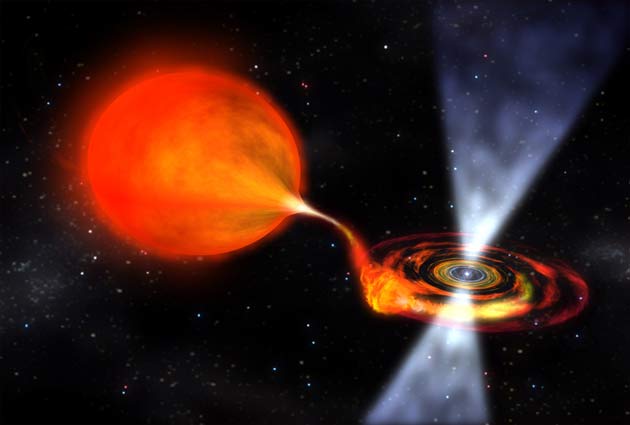Star Devours Companion

For stars, it seems, fortune favors the cannibal.
An international team of researchers has caught a star-turned-pulsar in the process of devouring its stellar neighbor, an act that accelerates its spin as it consumes more and more material.
The find, made using two space-based observatories, marks the first time astronomers have witnessed a pulsar speeding up it strips material from a companion star. [An animation of the process is available here via the European Space Agency (ESA).
Astronomers used the ESA's Integral gamma-ray observatory and NASA's Rossi X-ray Timing Explorer to observe the pulsar. The research will appear in an upcoming issue of the Astronomy and Astrophysics Journal.
"We're getting to the point where we can look at any fast-spinning, isolated pulsar and say, 'That guy used to have a companion,'" said Integral observation leader Maurizio Falanga, of Saclay, France's Commissariat ? l'Energie Atomique (CEA), in a statement.
The observations, researchers added, may help astronomers understand how slow-spinning pulsars in binary systems ramp up to become fast-spinning, solitary objects.
A pulsar is a spinning neutron star, which itself formed from the death of a massive star. Spinning neutron stars with strong magnetic fields can radiate energy like beacons as they spin, sending signals that appear as pulses - hence their name - to stationary observers.
Get the Space.com Newsletter
Breaking space news, the latest updates on rocket launches, skywatching events and more!
While they have about the same mass as the sun, neutron stars are much smaller, about 12 miles wide (20 kilometers) or so wide. The Sun, for comparison, is about 865,000 miles (1.4 million kilometers) in diameter.
The pulsar studied by Falanga and his colleagues, known as IGR J00291+5934, is the sixth found to be feeding off a companion star, but the first observed while increasing its spin rate. The pulsar is one of the fastest on record, sending out an intense X-ray signal once every 1.67 milliseconds, researchers said.
The Integral observatory first recorded the pulsar when it flared from its position in the outer region of the Milky Way galaxy on Dec. 2, 2004. Researchers then used NASA's Rossi timing spacecraft to clock the pulsar's speed. While the Rossi spacecraft has found four of the six binary pulsar systems, the find was a first for Integral, ESA officials said.
Using the Rossi observations, researchers found that the pulsar had already reduced its companion star to a size much smaller than that of the sun, leaving it with only 40 times the mass of Jupiter. Locked in a binary orbit smaller than the radius of the sun, the two objects complete a full cycle every 2.5 hours and are close enough to allow stellar cannibalization - known as accretion - to occur.
But the process won't last forever. Eventually, the pulsar will completely devour its companion and be left to spin alone.
"Accretion is expected to cease after a billion...years or so," said Duncan Galloway, responsible for the Rossi observations at the Massachusetts Institute of Technology.
This article is part of SPACE.com's weekly Mystery Monday series.
- The Heartbeat of a Dying Star
- Pulsar's "Fire Hose" Jet May Boost Understanding of Black Holes
- Neutron Star Collisions Common, Study Suggests
Join our Space Forums to keep talking space on the latest missions, night sky and more! And if you have a news tip, correction or comment, let us know at: community@space.com.

Tariq is the Editor-in-Chief of Space.com and joined the team in 2001, first as an intern and staff writer, and later as an editor. He covers human spaceflight, exploration and space science, as well as skywatching and entertainment. He became Space.com's Managing Editor in 2009 and Editor-in-Chief in 2019. Before joining Space.com, Tariq was a staff reporter for The Los Angeles Times covering education and city beats in La Habra, Fullerton and Huntington Beach. In October 2022, Tariq received the Harry Kolcum Award for excellence in space reporting from the National Space Club Florida Committee. He is also an Eagle Scout (yes, he has the Space Exploration merit badge) and went to Space Camp four times as a kid and a fifth time as an adult. He has journalism degrees from the University of Southern California and New York University. You can find Tariq at Space.com and as the co-host to the This Week In Space podcast with space historian Rod Pyle on the TWiT network. To see his latest project, you can follow Tariq on Twitter @tariqjmalik.









